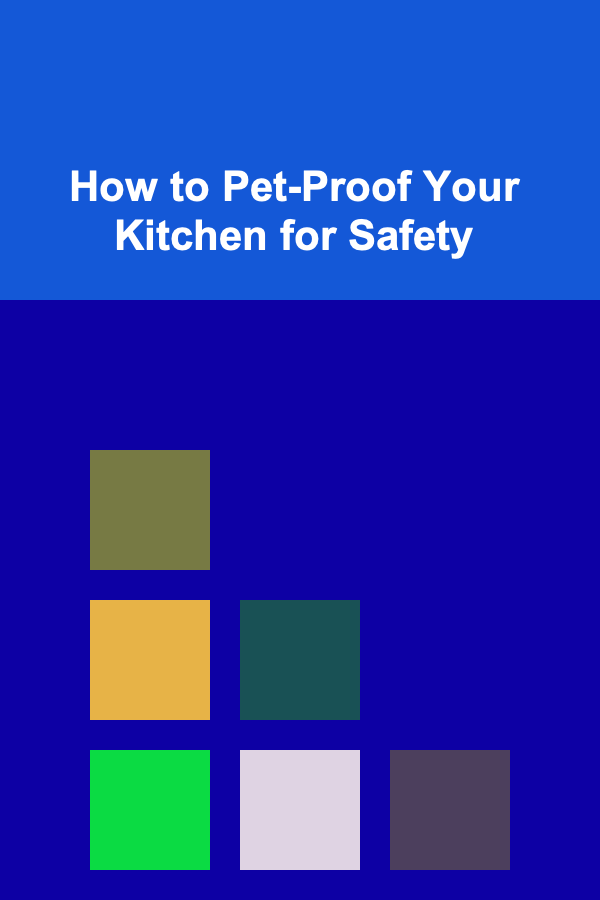
How to Pet-Proof Your Kitchen for Safety
ebook include PDF & Audio bundle (Micro Guide)
$12.99$10.99
Limited Time Offer! Order within the next:

Your kitchen is the heart of your home. It's a place where you prepare meals, store food, and gather with your family. But for pet owners, the kitchen can also pose many hazards for their furry companions. Whether it's a curious dog sniffing around for a tasty treat or a cat exploring high counters, the kitchen is full of potential dangers for pets. It's important to pet-proof this area to ensure their safety and protect your belongings.
This article will discuss in detail how to pet-proof your kitchen to prevent accidents, minimize risks, and create a safe environment for your pets. We'll explore various aspects, from securing food storage to safeguarding electrical appliances, and provide practical tips to keep your pet safe in the kitchen.
Keep Hazardous Foods Out of Reach
One of the most critical aspects of pet-proofing your kitchen is ensuring that your pet doesn't get access to foods that are harmful to them. Many foods that are safe for humans are toxic to pets. For example, chocolate, grapes, onions, and garlic are just a few of the foods that can cause severe harm to pets if ingested.
1.1 Store Food Safely
Make sure that all food, especially dangerous items, are stored securely away from your pet's reach. Here are some tips for food storage:
- Use sealed containers: Store foods, both human and pet-related, in airtight containers. This will keep the food fresh, but it will also prevent your pet from sniffing or pawing at food items that may be toxic to them.
- Secure cabinets and pantries: Pets, especially dogs and cats, are curious by nature. They might try to rummage through your cabinets and pantry looking for food. Use child-proof locks or pet-proof cabinet latches to secure any areas where food is stored.
- Place toxic foods high up: Certain foods, such as chocolate, coffee, grapes, and certain nuts, should always be placed in high cabinets or on shelves out of reach. Even foods that are not toxic to humans, like sugar, salt, or cooking oils, should be kept in sealed containers that your pet can't access.
- Avoid leaving food on countertops: Pets are clever and can be persistent. If you leave food out on the counter, your pet may be tempted to jump up and grab a snack. Always clean your countertops immediately after preparing meals and store food in the refrigerator or in secure containers.
1.2 Know Which Foods Are Dangerous
To better protect your pet, it's important to familiarize yourself with which foods are harmful. Here is a list of some of the most common toxic foods for pets:
- Chocolate: Contains theobromine, which can be lethal to dogs and cats.
- Onions and garlic: Both are toxic to pets and can cause digestive issues, lethargy, and even organ damage.
- Grapes and raisins: These can lead to kidney failure in dogs.
- Xylitol (found in sugar-free gum and candy): This sugar substitute is deadly to dogs, causing a rapid drop in blood sugar levels.
- Alcohol: Even small amounts can be dangerous for pets and may cause vomiting, diarrhea, and even coma or death.
By being mindful of what foods are in your kitchen and how you store them, you'll be able to significantly reduce the risk of your pet ingesting something harmful.
Secure the Trash and Compost
One of the most common places where pets get into trouble in the kitchen is the trash. Pets, particularly dogs, have a keen sense of smell, and the trash can be a tempting place for them to scavenge for food. However, garbage can contain not only leftover food but also items that can be hazardous to pets, such as bones, plastic packaging, and certain chemicals.
2.1 Use Pet-Proof Trash Cans
To prevent your pet from accessing the trash, invest in a trash can with a secure lid or one that has a pet-proof design. Here are some options to consider:
- Motion-activated lids: These trash cans open with the wave of your hand, making it hard for pets to open the lid themselves.
- Tight-fitting lids: Ensure the lid of the trash can closes tightly and securely. Some trash cans even come with locking mechanisms to prevent pets from getting inside.
- Trash can enclosures: You can also place your trash can inside a cabinet with a secure latch, preventing your pet from even seeing the garbage.
2.2 Compost Bins
Compost bins, often used for kitchen scraps, can be just as tempting for pets. Items like fruit peels and vegetable scraps might be enticing to your dog or cat, but compost can also contain substances like mold, yeast, or spoiled food that are harmful to your pet's health.
To secure your compost bin, consider using a sealed container with a locking lid, or store the compost bin in a cabinet that is inaccessible to your pet. Be sure to educate your family members about the importance of closing the compost bin after use to avoid any temptation for your pets.
Safeguard Cleaning Products and Chemicals
Kitchens are full of cleaning supplies that can be harmful or even deadly to pets if ingested. Cleaning chemicals like bleach, ammonia, and disinfectants are toxic to animals, and even seemingly harmless products, like certain dish soaps or floor cleaners, can pose a risk.
3.1 Store Cleaning Products in Secure Cabinets
Keep all cleaning products, including dish soap, disinfectants, and other chemicals, locked away in high cabinets. Child-proof or pet-proof cabinet locks are an effective solution for this. Pet-proof cabinet latches come in various styles, from magnetic locks to sliding bolt mechanisms, ensuring that your pet cannot get into dangerous chemicals.
3.2 Opt for Pet-Safe Cleaning Products
Consider using pet-safe cleaning products that are non-toxic and biodegradable. There are many options on the market that are designed to clean effectively while being safe for pets. Look for labels that indicate a product is safe for use around animals, and always read the instructions carefully to ensure you're using it correctly.
Keep Electrical Cords and Appliances Secure
Another major hazard in the kitchen is electrical cords. Pets, especially puppies and kittens, are notorious for chewing on cords, which can result in severe injury or even death. Electrical cords that hang down from appliances like toasters, blenders, and coffee makers can be tempting to a curious pet.
4.1 Hide or Protect Electrical Cords
To keep your pet from chewing on cords, here are some strategies:
- Use cord covers: Purchase cord protectors or covers that encase electrical wires to prevent pets from biting them. Many pet stores sell durable plastic tubing that can be slipped over exposed wires.
- Position cords out of reach: Place cords behind appliances or furniture so that they're not hanging down or easily accessible. If possible, use extension cords with outlets high off the ground to avoid low-hanging wires.
- Unplug unused appliances: Whenever possible, unplug appliances when they're not in use. This reduces the temptation for your pet to chew on a powered cord and also eliminates the risk of electric shock.
4.2 Secure Appliances
Heavy or easily tipped appliances, such as blenders, mixers, and coffee makers, can also pose a danger to pets if they are knocked over. To prevent accidents, consider securing these items to the countertop or using non-slip mats under appliances to keep them in place.
Protect Against Burns and Scalds
Hot surfaces and open flames in the kitchen present another risk for pets, especially curious dogs or cats that may jump up onto counters or stoves.
5.1 Use Stovetop and Oven Safety
- Use stovetop covers: Consider using stove knob covers to prevent your pets from accidentally turning on the stove burners. This is especially important if your dog or cat is able to access the kitchen when you're not around.
- Keep hot surfaces away from pets: Always be aware of where your pets are when cooking. Don't leave hot pots or pans unattended, as pets can accidentally knock them over or burn themselves.
- Install oven locks: If you have an oven that pets could potentially open, install an oven lock to prevent them from getting inside.
5.2 Keep the Floor Clean
While pets can't reach high surfaces like stoves or countertops, they are often close to the ground. Spilled food or dropped hot liquids could cause burns if your pet walks on them. Clean up spills promptly and avoid leaving hot items on the floor where your pet could step on them.
Install Pet-Friendly Flooring
Pet-proofing your kitchen also involves making sure the flooring is safe and easy to clean. Pets tend to track dirt, food, and water around, so having the right type of flooring can make cleanup much easier while keeping your pet safe.
6.1 Use Slip-Resistant Mats
Consider using non-slip mats under your pet's food and water bowls to prevent spills and keep the floor clean. If your kitchen floor is slippery, consider adding slip-resistant rugs to help prevent accidents and falls, particularly if you have an older pet or one with mobility issues.
6.2 Avoid Toxic Flooring Materials
When selecting flooring materials for your kitchen, choose pet-safe, non-toxic options. Some types of vinyl, laminate, or tile flooring contain harmful chemicals that can be toxic to pets if ingested. Opt for materials that are durable, non-slip, and easy to clean, while being free of harmful substances.
Conclusion
Pet-proofing your kitchen is essential for ensuring the safety and well-being of your pets. By securing food, trash, cleaning products, and electrical appliances, and by creating a pet-friendly environment, you can significantly reduce the risk of accidents and injuries. Remember that your pet's safety requires constant vigilance and ongoing adjustments as your pet grows and their behavior changes. With the right precautions in place, your kitchen can remain a safe and enjoyable space for both you and your furry companions.
Reading More From Our Other Websites
- [Home Maintenance 101] How to Maintain Your Stand Mixer for Longevity
- [Home Budget Decorating 101] How to Create a Bohemian Style Without Spending Much
- [Personal Finance Management 101] How to Navigate Student Loan Repayment Options When You're Fresh Out of College
- [Organization Tip 101] How to Create a Seasonal Decoration Rotation for Your Living Room
- [Home Holiday Decoration 101] How to Make Your Home Smell Like the Holidays with Scented Decor
- [Trail Running Tip 101] How to Use Heart‑Rate Zones Effectively During Variable‑Elevation Trail Sessions
- [Organization Tip 101] How to Plan for Rainy Days with Indoor Activities
- [Home Lighting 101] How to Choose the Right Lighting for Each Room in Your Home
- [Star Gazing Tip 101] Mastering Long Exposures: Techniques to Reveal the Night Sky's Hidden Details
- [Personal Finance Management 101] How to Interview and Choose a Financial Advisor for Long-Term Wealth Management

How to Budget for Your Home Renovation Without Over-Spending
Read More
How to Save for a Home Down Payment in Less Time
Read More
Smart and Practical Strategies for Reducing Car Maintenance Costs
Read More
How to Use a Clay Bar for Removing Contaminants from Car Paint
Read More
How to Bake the Perfect Sourdough: A Checklist for Beginners
Read More10 Tips for Habit Tracking with a Busy Schedule
Read MoreOther Products

How to Budget for Your Home Renovation Without Over-Spending
Read More
How to Save for a Home Down Payment in Less Time
Read More
Smart and Practical Strategies for Reducing Car Maintenance Costs
Read More
How to Use a Clay Bar for Removing Contaminants from Car Paint
Read More